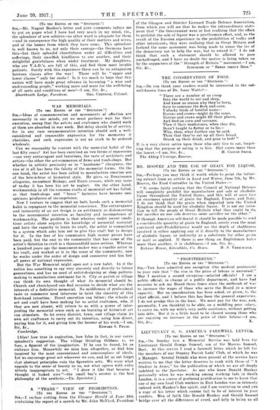WAR MEMORIALS.
[To THE EDITOR Or THE " SPECTATOR.")
Sur,—Ideas of commemoration and monuments of affection are necessarily in our minds, yet we must perforce wait for their execution, seeing that the artists and craftsmen who should work at them are absorbed in war work. But delay should be of service, for in any case commemorative intention should seek a well- considered and reasonable expression for the memories it cherishes, and such expression is not on stock to be ordered wholesale.
Can we reasonably be content with the memorial habit of the last fifty years? Art has been exercised on two forms of expression —one very extravagant and luxurious, the taste of architects and artists—the other the art-commerces of firms and tomb-shops. But whether in artistic preciosity or in " handsome" cheapness, the vice of it all has been the falsity of the memorial forms. On the one hand, the artist has been called to manufacture emotion out of the bric-h-brac of historical style. He gives us Renaissance allegories, recumbent Bishops, and Runic crosses, while any issue of to-day it has been his art to neglect. On the other hand, workmanship in all the common crafts of memorial art has failed, so that tomb-shops and " brass " factories have become con- spicuous producers of incompetence.
Now I venture to suggest that on both hands such a memorial habit is repugnant to the memorial conscience. The extravagance and insincerity of an art design is an art-luxury as dishonouring to the monumental intention as banality and incompetence of workmanship. The problem is that whereas under recent condi- tions artists alone acquire the knowledge of memorial material and have the capacity to learn its craft, the artist is committed to a system which asks him not to give this craft but to design for it. In the fees of his commission high money prices have been paid, but the cost to the community that has come of the artist's dictation to craft is a thousandfold more serious. Whereas a hundred years ago the monument-maker was a capable artist in his 'craft, and worked at it in the sense of the community, now he works under the order of design and commerce and has lost all power of national expression.
But the War Memdrial might open out a new habit. In it the nation has something to say very sincerely and directly to future generations, and has no need of artist-designing or shop pattern- making to manufacture sentiment for it. City or parish or village can think its own thought of what its memorial should be. Church and churchyard can find occasion to decide what are the interests of a dedicative memorial. No middleman of professional taste or commerce need intervene to taint the sincerity of this first-hand intention.' Direct execution can follow: the schools of art and craft have been making for us artist craftsmen, who, if they are now absent, will return to us with a power of inter- preting the memorial sense such as no learning of historical art can stimulate. So let every district, town, and village claim its own art craftsman to carry out its intention, using him direct, paying him for it, and giving him the honour of his work.—I am,
Cambridge.
[Alas! how true in aspiration, how false in fact, is our corre- spondent's suggestion. The village Grinling Gibbons is, we fear, a figment of the imagination. If he can be found, let us embrace him. Meanwhile we miss him altogether, or find him inspired by the most conventional and commonplace of ideals. Let us encourage great art wherever we can, and let us net forget that abstract principles ruin the figurative arts. We want what appeals to the sense of beauty in us, not what agrees with rules utterly inappropriate to art. " I drew it like that because I thought it looked nice "—the small boy's answer is the best philosophy of the aesthetic.—Ea. Spectator.]


































 Previous page
Previous page